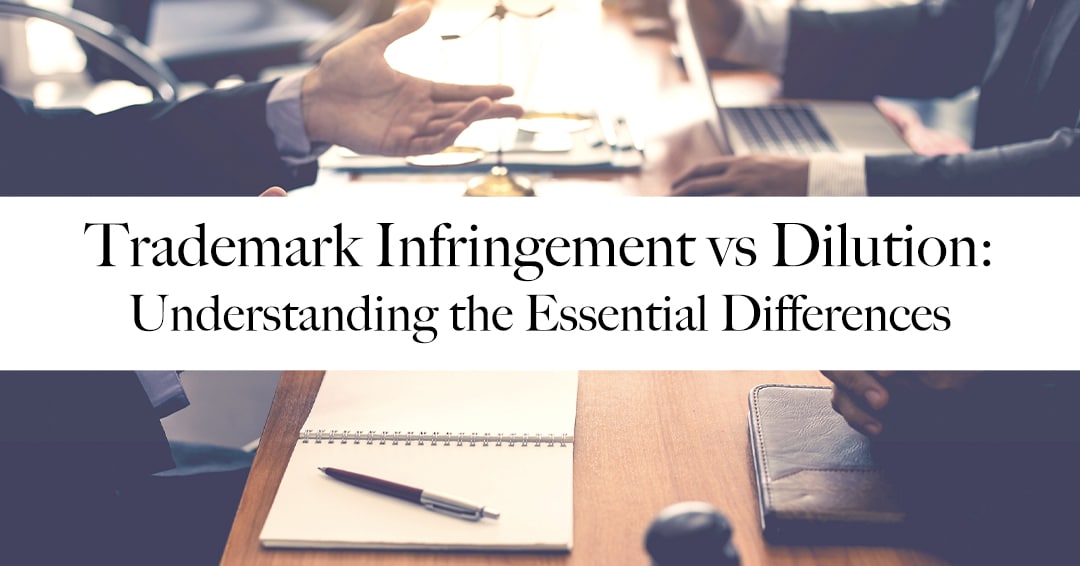Originally posted on December 5, 2023 @ 11:49 pm
I’m sorry, but it seems you haven’t given any text content for me to rephrase. Could you please offer the text that you need rephrased?
Trademark infringement and trademark dilution are two similar concepts that are often confused with one another. In the world of intellectual property law, it is crucial to understand the nuances of these terms and their implications for businesses and brand owners. This article delves into the definitions, legal consequences, prevention methods, and key differences between trademark infringement and dilution. Additionally, we will provide insights into how to protect your trademark effectively.
Understanding Trademark Infringement
Trademark infringement occurs when a person or entity uses a similar or identical mark to a registered trademark without authorization. This unauthorized use can lead to confusion among consumers, which has a detrimental impact on the trademark’s distinctive value.
When a trademark is infringed upon, it can have serious legal consequences. The trademark owner has the right to protect their mark and seek remedies for the infringement, such as:
- Injunctive Relief: A court order that prohibits the infringing party from using the mark
- Monetary Damages: Compensation paid to the trademark owner for any harm caused by the infringement.
- Criminal Penalties: In some cases, trademark infringement may even result in criminal penalties. This is particularly true when the infringement is intentional and done with the intent to deceive consumers or profit from the reputation of the original trademark.
Preventing Trademark Infringement
Preventing trademark infringement is crucial for brand owners. It is important to take proactive steps to protect your trademarks and ensure that they are not being used without authorization.
- Research: One of the key steps in preventing infringement is conducting thorough trademark searches before adopting a new mark. This involves researching existing trademarks to determine if there are any similar marks already registered or in use. By conducting these searches, businesses can identify potential conflicts and avoid adopting a mark that may infringe on someone else’s rights.
- Market Monitoring: Businesses should actively monitor the marketplace to identify any potential infringement. This can involve monitoring online platforms, such as e-commerce websites and social media platforms, as well as keeping an eye on competitors and industry trends.
- Legal Action: If a potential infringement is identified, it is important to take prompt action. This can include sending cease and desist letters to the infringing party, initiating legal proceedings, or seeking alternative dispute resolution methods, such as mediation or arbitration.
By being proactive and vigilant in protecting their trademarks, brand owners can minimize the risk of infringement and maintain the distinctiveness and value of their marks.
Exploring Trademark Dilution
Trademark dilution is another important legal concept that pertains to the protection of famous and distinctive trademarks. Unlike infringement, dilution does not require proving the likelihood of consumer confusion. Rather, it is concerned with the dilution or blurring of the distinctive quality of a famous mark.
Definition of Trademark Dilution
Trademark dilution is a legal concept that seeks to prevent the unauthorized use of a similar or identical mark that may weaken the distinctiveness or reputation of a famous mark. It recognizes that the value of a famous mark lies not only in its ability to identify the source of goods or services but also in its ability to evoke a certain level of recognition and association with the trademark owner.
By prohibiting dilution, trademark law aims to safeguard the investment and goodwill that trademark owners have built in their marks. It recognizes that the dilution of a famous mark can have long-lasting negative effects on the trademark owner’s business and the overall marketplace.
Types of Trademark Dilution
There are two primary types of trademark dilution: blurring and tarnishment.
- Blurring: This type of dilution occurs when the unauthorized use of a mark weakens its distinctiveness, making it less unique and memorable in the minds of consumers. This can happen when a mark is used in connection with unrelated goods or services, causing consumers to associate the mark with a broader range of products or services.
- Tarnishment: This can occur when the unauthorized use of a mark harms its reputation. This can occur when a mark is used in a way that portrays the trademark owner or its products or services in a negative or unfavorable light. Tarnishment can damage the goodwill and reputation that a famous mark has built over time, potentially leading to a loss of consumer trust and loyalty.
Legal Remedies for Trademark Dilution
In cases of trademark dilution, the trademark owner can seek various legal remedies to protect their rights and the distinctiveness of their mark. Common remedies include injunctive relief, seeking monetary damages, and the destruction of infringing products or materials that bear the diluting mark.
Legal remedies for trademark dilution play a crucial role in maintaining the integrity of famous marks and ensuring that they continue to serve as reliable indicators of source. By providing protection against unauthorized use, dilution laws help preserve the value and distinctiveness of well-known trademarks in the marketplace.
Key Differences Between Trademark Infringement and Dilution
Basis of Legal Action
The primary difference between trademark infringement and dilution lies in the basis of legal action. Infringement requires the likelihood of confusion, while dilution seeks to preserve the uniqueness and reputation of famous marks regardless of consumer confusion.
Trademark infringement occurs when a party uses a mark that is identical or similar to another party’s registered trademark in a way that is likely to cause confusion among consumers. This confusion may lead consumers to mistakenly believe that the goods or services associated with the infringing mark are connected to or endorsed by the trademark owner.
In contrast, dilution is concerned with the protection of famous marks. Famous marks are those that have acquired a high level of recognition and distinctiveness in the marketplace. Dilution occurs when a party uses a famous mark in a way that blurs or tarnishes its distinctiveness or reputation, even if there is no likelihood of confusion among consumers.
Proof Requirements
Although they are similar concepts, there are different proof requirements when pursuing legal action against infringement and dilution,
| Trademark Infringement | Dilution |
| The trademark owner must demonstrate that there is a likelihood of confusion among consumers. This can be shown through evidence such as consumer surveys, instances of actual confusion, or similarities between the marks and the goods or services offered. | The trademark owner must show that the unauthorized use of the mark is likely to impair its distinctiveness. This can be demonstrated by presenting evidence of the mark’s fame, the degree of similarity between the marks, and the extent to which the unauthorized use is likely to harm the mark’s distinctiveness or reputation. |
In some jurisdictions, dilution may require a higher standard of proof compared to infringement. For example, in the United States, federal law requires a showing of actual dilution or a likelihood of dilution, which is a more stringent requirement than the likelihood of confusion standard for infringement.
Impact on the Trademark Owner
Trademark infringement directly affects the trademark owner’s market share and brand reputation by causing confusion among consumers. When consumers are confused about the source of goods or services, they may choose to purchase from the infringing party instead of the legitimate trademark owner, leading to financial losses and damage to the owner’s reputation.
In contrast, dilution can harm the distinctiveness and reputation of a famous mark, diminishing its overall value. For example, if a famous luxury brand’s mark is used on low-quality or counterfeit products, it can tarnish the brand’s reputation for exclusivity and quality. Similarly, if a famous mark is used on unrelated goods or services, it can blur the mark’s distinctiveness and dilute its association with the original goods or services.
Overall, while trademark infringement and dilution both involve unauthorized use of a mark, they differ in their focus, proof requirements, and impact on the trademark owner. Understanding these differences is crucial for trademark owners seeking to protect their rights and maintain the value of their marks in the marketplace.

Protecting Your Trademark
Protecting your trademark is crucial in maintaining the integrity and value of your brand. By taking the necessary steps to register your trademark and actively monitor and enforce your rights, you can ensure that your brand is protected from potential infringements or dilutions.
Trademark Registration Process
Registering your trademark with the appropriate government authority is a vital step in protecting your brand. A registered trademark provides stronger legal protection and allows for enforcement actions against infringers. Registering your trademark should involve the following:
- Researching Your Trademark: Before registering your mark, it is important to conduct a comprehensive search to ensure that your desired trademark is not already in use by another party. This search helps avoid potential conflicts and strengthens your chances of successfully registering your mark.
- Registration Process: The process of registering your mark typically involves submitting an application, paying the required fees, and providing evidence of the mark’s distinctiveness and intended use.
- Trademark Documentation: Once your trademark is registered, you will receive a certificate of registration, which serves as proof of your ownership and exclusive rights to use the mark in connection with the goods or services specified in the registration.
Monitoring and Enforcing Your Trademark Rights
Trademark owners should actively monitor the marketplace for potential infringements or dilutions. Regular monitoring helps identify unauthorized uses and allows for prompt enforcement actions to protect the mark’s integrity.
Monitoring can be done through various means, such as:
- Conducting online searches
- Monitoring industry publications
- Engaging the services of professional trademark watch services
By staying vigilant, you can identify potential infringements early on and take appropriate action to prevent further damage to your brand.
Dealing with Potential Infringement or Dilution
If a trademark owner encounters potential infringement or dilution, it is essential to consult with legal counsel to evaluate the strength of the case and determine the appropriate course of action. Taking swift and decisive action can help safeguard the trademark’s value and protect the brand’s reputation.
- Seeking Legal Counsel: Legal counsel can assist in assessing the potential risks, gathering evidence, and formulating a strategy to address the infringement or dilution. They can guide you through the legal process, represent your interests, and help negotiate settlements or pursue litigation if necessary. Be sure to seek counsel from a legal professional well versed in copyright law.
- Understanding Territorial Rights: Trademark rights are territorial, meaning they are generally only enforceable within the jurisdiction where the mark is registered. If you plan to expand your business internationally, it is advisable to seek trademark protection in each desired jurisdiction to ensure comprehensive protection of your brand.
Protecting your trademark requires proactive measures such as registration, monitoring, and enforcement. By investing time and resources into safeguarding your brand, you can maintain its distinctiveness, reputation, and value in the marketplace.
Navigating Trademark Infringement and Dilution
Trademark infringement and dilution are distinct legal concepts that require careful consideration and proactive protection. Understanding the definitions, legal consequences, and differences between these two concepts empowers brand owners to safeguard their intellectual property rights effectively. By registering their trademarks, monitoring the marketplace, and taking swift action against potential infringements, businesses can preserve the distinctiveness and reputation of their valuable trademarks.



